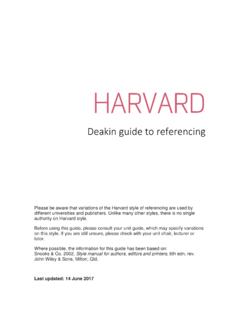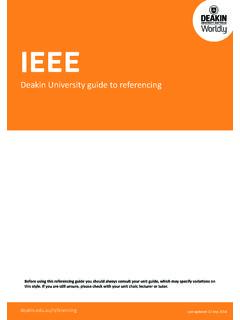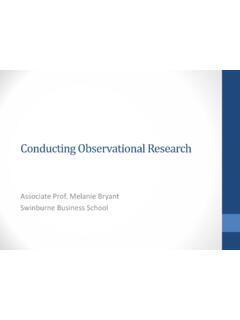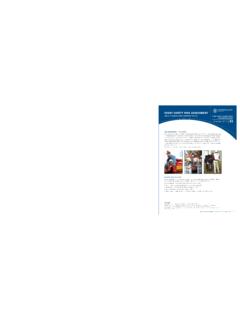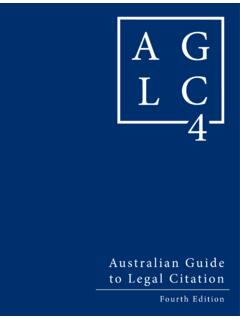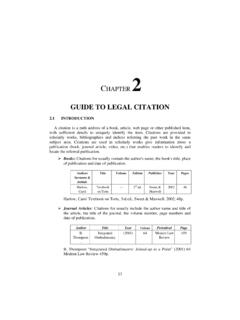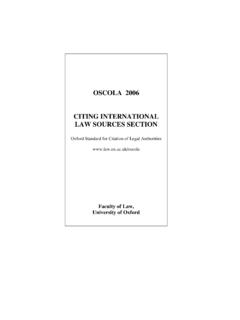Transcription of Deakin guide to Australian Harvard
1 Deakin guide to Australian Harvard Different disciplines and units at Deakin use different referencing styles. Always check your unit assessment information to find which style you are required to use. Please be aware that different versions of the Harvard style of referencing are used by different universities and publishers. Check with your teacher, supervisor or publisher whether you are required to follow a version of the Harvard style that differs from the advice presented in this guide . This guide has been adapted from advice provided in the Australian Government Style Manual: Digital Transformation Agency (2020) Author-date, Australian Government Style Manual, Commonwealth of Australia, accessed 8 October 2020.
2 Last updated: 30 June 2021 Deakin guide to Australian Harvard Last updated: 30 June 2021 2 Table of Contents Harvard explained .. 4 Overview .. 4 In-text 4 Direct quotes .. 5 Reference list .. 7 Number of authors .. 9 Group author ..10 No author ..10 No date ..11 Titles ..12 No page number ..12 Multiple citations ..13 Same author ..13 Source within a source ..14 DOIs and URLs ..15 Translation ..16 Books .. 17 Overview ..17 e-book ..18 Edition ..18 Editors and translators ..19 Place ..19 Chapter ..20 Journal articles .. 20 Overview ..20 Article on a website.
3 21 Article number ..22 Article in press ..22 Review ..22 Government, NGO and legal .. 23 Government overview ..23 ABS ..24 Bills ..25 Cases ..25 Legislation ..26 NGO ..27 Parliamentary source ..28 Treaties ..28 Web and video .. 29 Overview ..29 Web page ..30 Web document ..31 Blog post ..32 Deakin guide to Australian Harvard Last updated: 30 June 2021 3 Social media post ..33 Online Film ..35 TV episode ..36 Podcast ..37 Other sources .. 38 Artwork ..38 Construction regulation ..39 Computer code ..39 Conference paper ..40 Dataset ..40 Deakin course content.
4 41 Dictionary or encyclopaedia ..41 Digital collection ..42 Figures and tables ..43 Industry report ..45 Media release ..46 News article ..46 Personal communication ..47 Other print sources ..48 Report ..48 Song ..49 Standard ..49 Thesis ..50 Unpublished source ..51 Deakin guide to Australian Harvard Last updated: 30 June 2021 4 Harvard explained Overview The Australian Harvard style of referencing consists of two elements: In-text citations in the body of the paper provide the author, date and often a page number. A reference list at the end of the paper provide full bibliographic details of all in-text citations.
5 Note: you may not always find an example of the specific source you need to reference. In this case, you may need to combine topics from more than one section of this guide to determine the correct referencing format. We recommend first browsing the Harvard Explained section as well as the Overview topics. Follow the logic of this guide as much as possible, and always be clear and consistent in ordering and formatting the details of your sources. In-text citations For in-text citations in Harvard , provide: the family name of the author(s) or the organisation/department(s) and the year of publication page numbers when quoting directly from a source page numbers when paraphrasing (recommended) a colon between the year and the page number (or other locator) a corresponding entry in the reference list.
6 When using in-text citations, you can emphasise the author: Wood (2002:64) believes that the ethical culture of an organisation does not develop from company decree alone . Or the information: The ethical culture of an organisation does not develop from company decree alone (Wood 2002:64). If the citation is from more than one page, include the page range in the in-text citation: The ethical culture of an organisation does not develop from company decree alone (Wood 2002:64 5). Important: in addition to citing your sources it is essential to comment on and analyse your sources.
7 There are three main ways to include sources in your work: summarising, paraphrasing or directly quoting. 1. Summarising your source A summary of a work or section of a work, or a general reference to someone's theory or idea, always requires a citation. Include the author(s) and the date: Whelan and Fink (2016) observe that sustainable practices can lower operational costs. Deakin guide to Australian Harvard Last updated: 30 June 2021 5 2. Paraphrasing your source A paraphrase accurately conveys the meaning of a brief and specific section of text from a source and in roughly the same number of words.
8 Include the author(s) and the date. We also recommend including a page number (or other locator if there are no page numbers, paragraph number): Hughes et al. (2012:567) suggest the information sought from Facebook is more likely to be obtained socially, for example .. 3. Quoting your source A direct quote is the exact reproduction of someone s words. Only quote a source when it is essential that the reader sees the original wording for example, it may be a memorable quote, a definition, regulation, legislation, a literary work or a controversial statement.
9 Note: It is rare in the sciences to quote a source, but it is more common in disciplines such as History, Literature, and in disciplines where policy documents or regulations need to be cited. For direct quotes of less than 30 words: include the author, the date, and the page number (or for web sources you may use another locator paragraph number or section title) enclose the quote in single quotation marks place the full stop inside the quote marks only if this is part of the original quote. From this perspective, it appears that our social structure too is oriented towards this model, in a form of electronic solidarity (Butler et al.)
10 2009:18). For further information on Direct quotes see the next topic. Learn more about summarising, paraphrasing and quoting sources. Direct quotes Only directly quote a source when it is essential that the reader sees the original wording. For example, it may be a memorable quote, a definition, regulation, legislation, a literary work or a controversial statement. Note: While it is more common to provide direct quotes in disciplines such as History, Literature and in disciplines where policy documents or regulations need to be cited, it is less common in the sciences.

